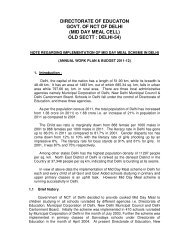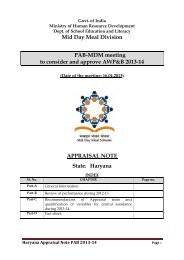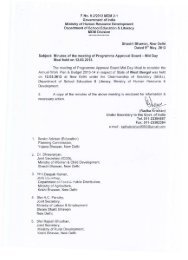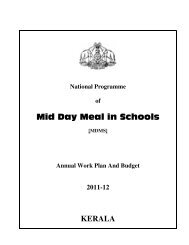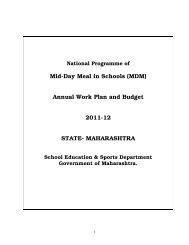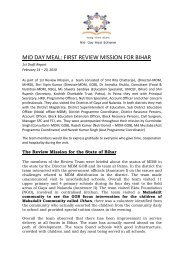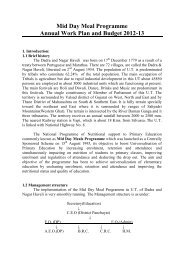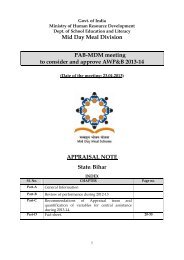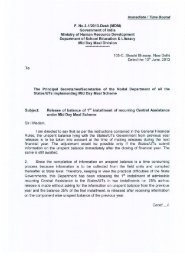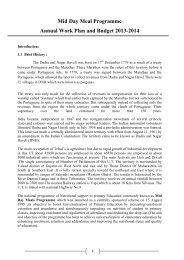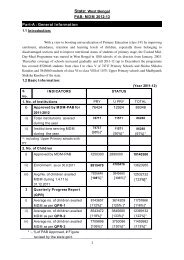Mid Day Meal Programme - Mid Day Meal Scheme
Mid Day Meal Programme - Mid Day Meal Scheme
Mid Day Meal Programme - Mid Day Meal Scheme
Create successful ePaper yourself
Turn your PDF publications into a flip-book with our unique Google optimized e-Paper software.
<strong>Mid</strong> <strong>Day</strong> <strong>Meal</strong> <strong>Programme</strong><br />
Annual Work Plan and Budget 2011-12.<br />
1. Introduction :<br />
1.1 Brief history.<br />
National programme of Nutritional Support to Primary Education (Known<br />
as the <strong>Mid</strong>-<strong>Day</strong> –<strong>Meal</strong> programme ) was launched as a CSS on 15 th<br />
August 1995.Cooked <strong>Mid</strong> –<strong>Day</strong> <strong>Meal</strong> programme has been started in<br />
Assam with effect from January/2005. The <strong>Programme</strong> is expected to boost<br />
and sustain the pace of achieving the objectives under UPE like Universal<br />
enrolment , Universal retention and quality improvement.<br />
1.2 Process of plan Formulation.<br />
The Annual Work Plan and Budget 2011-12 is formulated on the basis of<br />
data / Information collected from the district level plan submitted by the<br />
district level officers. A work shop was organized by the Directorate of<br />
Elementary education which was attended by all field level functionaries to<br />
facilitate formulating the Annual Work Plan & Budget 2011-12.<br />
2. Description and assessment of the programme implementation in the current<br />
year 2010-11 and Proposal for next year ( 2011-12 )with reference to :<br />
2.1 Regularity and wholesomeness of mid day meals served to children ,reasons<br />
for programme Interruptions, if any and planning to minimize them.<br />
The State Govt. has taken all possible cares for running cooked <strong>Mid</strong>-<strong>Day</strong> -<br />
<strong>Meal</strong> regularly. VEC and SMC have been associated in implementation of<br />
<strong>Mid</strong> -<strong>Day</strong>-<strong>Meal</strong> <strong>Programme</strong> . Mother groups are also given an important role<br />
in implementation of Cooked <strong>Mid</strong>-<strong>Day</strong> -<strong>Meal</strong> in Assam. Moreover, the<br />
implementation of MDM at district level is being reviewed bi -monthly at<br />
State Level. Though some interruptions have been noticed in<br />
implementation of MDMs in some places due to bandh call by some<br />
organizations and local disturbances, the State Govt. has instructed the<br />
District Nodal Officer to take steps to increase the number of days for<br />
serving <strong>Mid</strong>-day –<strong>Meal</strong> meals to make up the loss of MDM days.<br />
Weekly Menu of cooked <strong>Mid</strong> day meal:<br />
The following weekly menu has been prescribed by state for cooked mid -<br />
day meal.<br />
1. 2 days : Rice, Dal & vegetables<br />
2. 2 days : khichdi with vegetables<br />
3. 2days: Rice,Dal with local option(Seasonal green leafy Vegetables,<br />
fish,egg etc)<br />
SMC has been instructed to display weekly menu on the notice board of<br />
School veranda.<br />
1
2.2 System for payment of cost of food grains to FCI .Foodgrains management,<br />
including adequacy of allocation ,timeliness of lifting , transportation and<br />
distribution ,and suitability of storage at different levels. Challenges faced and<br />
plan to overcome them.<br />
During 2010-11 the Central Govt. has issued new guidelines for making<br />
payment of cost of food grains. According to the new system the district<br />
authority of FCI will submit bills of lifting food grains to the DNO for payment<br />
of cost of food grains. The DNOs will submit the requirement of cost of food<br />
grains to the SNO ,MDM who will release the amount according to<br />
availability of fund. The SNO,MDM has released the cost of food grains<br />
upto Nov./10.<br />
The Central Govt. has released the allocation of rice on the basis of<br />
average attendance of students in the schools .Rice allocation has been<br />
made district wise by the SNO,MDM at state level and break up of district<br />
wise allocation of rice has been communicated to the DNOs and FCI<br />
authority. In the current year the Govt. of India has released rice and cost of<br />
cooking cost on the basis of 41,33,720 enrolment in the state. Most of the<br />
school authority have stored the rice in the store rooms of kitchen-cum –<br />
store. The concept of district level storage for keeping rice as buffer stock<br />
may be considered by the Govt. However transportation cost not yet<br />
released by the Govt., due to which transporter are pressing hard for<br />
payment of transportation cost .<br />
2.3 System for release of funds provided under cooking costs (Central and State).<br />
Please indicate the dates when the fund was released to Directorate /State<br />
Authority, District/ Block /Gram Panchayat and finally to the Cooking<br />
Agency/School.<br />
The State Govt. releases the fund to SNO, MDM & Director of Elementary<br />
Education, Assam after receiving the concurrence from State Finance<br />
Deptt. The Director of Elementary Education presents the bill of the<br />
sanctioned amount to the Treasury office and the SNO, MDM after<br />
receiving the fund from Treasury immediately releases the same to the<br />
DNO, MDM. The DNO, MDM release the fund to the SMC (School<br />
Managing Committee). In the process takes about 2 to 3 months for<br />
receiving the fund by the SMCs.<br />
2
Fund flow:<br />
MHRD<br />
State Govt<br />
SNO, MDMS & DEE,Assam<br />
DNO , MDMS & Deputy Comissioner/Principal Secy,Autonomous Council<br />
SMC<br />
Table of receiving and release of fund under MDMs<br />
Instalement<br />
Date of<br />
receive of<br />
central share<br />
by state<br />
Date of release<br />
of fund to<br />
SNO,MDMS &<br />
DEE<br />
Date of realease<br />
of fund to the<br />
districts by<br />
SNO,MDMS<br />
1 2 3 4<br />
Adhoc grant 19-5-2010 June to<br />
August,2010<br />
August &<br />
September,2010<br />
Balance of 1 st<br />
instalment<br />
24-9-2010 Novemebr &<br />
December<br />
,2010<br />
November &<br />
December ,2010<br />
2.4 System for payment of honorarium to cook-cum-helpers and implementing<br />
agencies viz NGOs/trust/centralized kitchens etc :<br />
The SNO draws the amount for honorarium to cook-cum-helpers and<br />
releases the same the DNOs. The DNOs released the honorarium of cookcum-helpers<br />
to the SMC .The SMC finally makes the payment to cook-cumhelpers.<br />
As regards centralized kitchen the only NGO viz Akhay Patra<br />
Foundation receives the fund from DNO, Kamrup and make payment to the<br />
Cook-cum-helpers.<br />
2.5 System for procuring cooking ingredients: (Pulses, vegetables including leafy<br />
ones, salt, condiments, oil and fuel etc.) Commodities, which are centrally<br />
purchased and supplied to school or locally purchased at school level.<br />
The SNO (State Nodal Officer ) releases the fund of cooking cost to the<br />
DNOs for purchasing the ingredients like(Pulses, vegetables including leafy<br />
ones ,salt, condiments, oil and fuel etc).The DNOs release the fund to the<br />
SMC for purchase of above ingredients locally so that session wise available<br />
vegetable can be provided in the meals. However some schools located<br />
3
within Guwahati city it has been arranged to provide MDM through an NGO<br />
Akshay Patra.<br />
2.6 System for cooking, serving and supervising mid day meals in the school and<br />
measures to prevent any untoward happening.<br />
The School Managing Committee (SMC) engages cook-cum-helper mainly<br />
from mother group. Further Mother group also help in serving cooked food<br />
to the Children.SMC/VEC members supervising the implementation of the<br />
scheme. The Deputy Commissioner (DNO) is taking measures so that there<br />
is no untoward happening in the implementation of MDM in schools. The<br />
State Govt. is going to provide Fire Extinguishers in the schools and keep<br />
away toxic and inflammable materials from the class rooms.<br />
2.7 Procedure for getting Kitchen shed constructed.<br />
The State Govt. has engaged two construction agencies namely<br />
HOUSEFED and Assam State Housing Board for construction of Kitchen<br />
cum store under MDM programme. The above agencies accordingly<br />
constructed 28490 kitchen shed cum store in 28490 schools. The<br />
Construction works for 14063 schools are in progress and expected to<br />
complete within March/11. The SNO have already released an amount of<br />
Rs. 20322.64 lakh for that purpose to the construction agencies.<br />
2.8 Procedure of procurement of kitchen devices from (i) funds released under the<br />
<strong>Mid</strong> <strong>Day</strong> <strong>Programme</strong> (ii) other sources.<br />
The State Govt. have engaged Assam Govt. Marketing Corporation and<br />
Assam Industries Development Corporation for procurement of kitchen<br />
devices and to deliver the same at Block Level Offices .The SMC collects<br />
the same from the Block Offices.<br />
2.9 Capacity building and training conducted for different categories of persons<br />
involved in the <strong>Mid</strong> - <strong>Day</strong> <strong>Meal</strong> <strong>Programme</strong>.<br />
NUEPA organized a three day orientation programme w.e.f. August, 24-26<br />
,2009 of best practices in implementation of <strong>Mid</strong> <strong>Day</strong> <strong>Meal</strong> at NEHU<br />
Campus Shillong for the Officers of North Eastern States who are involved<br />
in implementation of <strong>Mid</strong> <strong>Day</strong> <strong>Meal</strong>s.<br />
SSA as well DIETs have also conducts training programme for<br />
teachers to orient them as regards best practices in the schools for<br />
implementation of <strong>Mid</strong> <strong>Day</strong> <strong>Meal</strong>s.Moreover State Govt. have organized time<br />
to time orientation programme for field level functionaries involved in<br />
implementation of MDMs.<br />
4
Moreover MHRD have also organized one two days orientation training<br />
programme for the Officers engaged in <strong>Mid</strong> <strong>Day</strong> <strong>Meal</strong>s programme in North<br />
Eastern States on 19 th and 20 th January/11 at Aizwal .<br />
2.10 Management Information System at school , village/ Gram Panchayat, Block,<br />
District and state levels and its details.<br />
The Director of Elementary Education ,Assam and SNO ,MDM takes the<br />
help of MIS of SSA for collection of school wise information. The Directorate<br />
of Elementary Education, Assam has no separate MIS till date. It is very<br />
much essential to have a full flagged MIS to look after the school information<br />
of elementary education as well as implementation of MDM program me.<br />
2.11 System to ensure transparency and openness in all aspects of program me<br />
implementation, including inter alia, food grains management, ingredients<br />
procurement ,cooking and serving, appointment of cooking staff, construction of<br />
kitchen sheds, and procurement of cooking devices.<br />
The State Govt. Education Department maintains transparency and<br />
openness in all aspects of programme implementation of <strong>Mid</strong> <strong>Day</strong> <strong>Meal</strong>s<br />
<strong>Programme</strong>. The DNOs allocate food grains to the GPSS as per allocation<br />
of food grains made by the SNO,MDM. Accordingly the GPSS lift the food<br />
grains from FCI godown and deliver the same to the school through FPS.<br />
The others ingredients like pulses, vegetables ,oil, condiments, fuel etc are<br />
purchased by the SMC of schools..The SMC engages cook-cum- helpers for<br />
cooking hot cooked meals. Further the State Govt. have entrusted<br />
HOUSEFED and Assam State Housing Board for construction of Kitchen<br />
cum store and AGMC, ASIDC have been engaged for supply of cooking<br />
devices.<br />
2.12 Measures taken to rectify:<br />
a) Inter-district low and uneven utilization.<br />
The state Govt. have issued instructions to the DNOs and Field level<br />
Officers of Education Department to increase the number of days for<br />
serving cooking <strong>Mid</strong>-<strong>Day</strong>-<strong>Meal</strong> regularly and also look into the position of<br />
availability of food grains as well as cooking cost.<br />
b) Intra-district mismatch in utilization of food grains and cooking cost.<br />
In order to reduce the Inter-district mismatch in utilization of food grains<br />
and cooking cost the state Govt. reviews the position of field level by<br />
holding a bimonthly review meeting on MDMs. The field level Officers of<br />
different district exchange their views in the meeting. However due to<br />
some local problems inter district mismatch could not be rectified fully.<br />
c) Delay in delivering cooking cost at school level.<br />
5
The DNOs have been asked for timely release of the cooking cost to the<br />
SMC and timely issue allocation of rice to the GPSS so that continuity of<br />
serving MDMs does not suffer.<br />
2.13 Details of Evaluation studies conducted and summary of its findings.<br />
The State Govt. engaged Mahila Samata Society to conduct external<br />
evaluation on MDMS in 9 districts and ACE Institute to conduct external<br />
evaluation on the implementation of cooked <strong>Mid</strong>-<strong>Day</strong> <strong>Meal</strong> in the remaining<br />
18 districts respectively. Both the organisations have submitted their<br />
Evaluation report. A summary findings of ACE Institute is given below.<br />
The External Evaluation Study on MDMS in schools of Assam,<br />
conducted in 2009, provides information on overall functioning of the<br />
scheme and its impact on increase of enrolment, attendance and retention<br />
of students in the primary and upper primary schools. The Ace Institute,<br />
Guwahati was entrusted to conduct the study and provide the results of the<br />
same. The Ace Institute conducted the survey in 2009 with a coverage of<br />
4601 primary and upper primary schools in the 18 selected districts of<br />
Assam.<br />
Objectives of the study:<br />
The overall objective of the study is to assess the impact of the MDMS on<br />
increase of enrolment, attendance and retention rate of the childrenparticularly<br />
the disadvantaged children in the primary and upper primary<br />
schools of Assam. The other objectives are (i) to examine the status and<br />
availability of infrastructure of the schools undertaking the <strong>Mid</strong>-day <strong>Meal</strong>, (ii) to<br />
evaluate overall the functioning of the MDMS in selected schools.<br />
Operation and logistic of MDMS:<br />
The study reveals that about 28 per cent schools have served mid-day meals<br />
on less that 100 days, 24 per cent have served on 100- 124 days, 20 per cent<br />
from 125- 149 days, 13 per cent from 150 - 174 days, about 11 per cent<br />
schools have served MDM from 175-224 days. Only less than 1 per cent (19<br />
schools) have served mid-day meal 225- 254 days. There is a scope to ask<br />
question why most of the schools have served mid-day meals on even less<br />
than 150 days.<br />
6
Though clear guidelines were given to the schools to display of weekly menu,<br />
the study finds that only about 24 per cent schools observed the guidelines,<br />
others did not.<br />
The investigators of the survey find in about 30 per cent schools where<br />
Dal+vegetable+rice combined meals were prepared and served, 25 per cent<br />
schools prepared khichri. Payas, pulao, biriyani etc. had not been found<br />
favourable item in many schools. Moreover, it is to be mentioned that about<br />
34 per cent schools could not mange to show their menu on the day of<br />
investigators’ visit as they did not prepare their meals at that time. Variation in<br />
menu is comparatively less- it is about 22 per cent only.<br />
Regarding patterns of gender, castes of the cooks and helpers it is observed<br />
that about 89 per cent cooks are female. The caste composition of the cooks<br />
consists of SC(13 per cent),ST (18 peer cent), OBC (27 per cent) Tea Tribe (4<br />
per cent), General (19 per cent) and Muslim about 17 per cent. It is observed<br />
that the cooks are appointed from the localities of the schools for which the<br />
caste of cooks mostly reflects the caste of the local population.<br />
In case of helpers mostly females (58 per cent) helpers are appointed against<br />
only 4 per cent of male helpers. The caste and community of helpers are also<br />
similar to the caste and community of the cooks.<br />
About 82 per cent cooks received payment regularly against about 15 who<br />
received partly. On the other hand only 50 per cent helpers received payment<br />
regularly as well as partly. About 38 per cent schools have no helpers<br />
appointed.<br />
About 85 per cent schools have utensils for cooking MDM and 47 per cent<br />
schools have storage facility in kitchen sheds. However 14 per cent use<br />
teachers house, 4 per cent use fair price shops and 23 per cent use class<br />
rooms as store for keeping food grains.<br />
Most of the schools (94 per cent) use firewood as fuel for cooking MDM<br />
against 5 per cent schools that use LPG and 1 per cent use kerosene and<br />
other fuel.<br />
About 71 per cent schools are found to have source of drinking water in the<br />
premises of the school. About 69 per cent use hand pump water, 4 per cent<br />
tap water, 9 per cent ring well water, 3 per cent pond water. Other schools<br />
use other source of water. It is also observed that about 57 per cent schools<br />
have water filter to filter drinking water for the students.<br />
In regard to involvement of teachers in cooking process the study finds that 68<br />
per cent teachers participated in cooking process of MDM.<br />
Regarding nutritional aspects, hygienic and good practices and management<br />
of hazard and wastage the study finds some interesting results. Masur dal (48<br />
per cent) and mixed dal (43 per cent ) are two types of dal which are used<br />
mostly in MDM. About 77 per cent school use leafy vegetable in the MDM<br />
served in the schools. Utensils and plates used for MDM have relation with<br />
the hygienic state of the food. For taking mid-day meals in about 79 per cent<br />
schools stainless steel plates are use in about 8 per cent aluminium plates, in<br />
7
about 6 per cent plastic plates and in about 6 per cent disposable plates.<br />
However for cooking foods mostly 60 per cent schools use aluminium pots<br />
and 37 per cent schools use iron pots respectively.<br />
Nutritional aspect, hygiene, good practice and management of hazards<br />
and wastage:<br />
With mid-day meal the maintenance of nutrition in foods is also attached. So<br />
imparting education on nutrition is one of the most important interventions.<br />
This study finds that in about 52 per cent schools nutrition education was<br />
imparted.<br />
About 89 per cent schools adhered to hygienic practices to be maintained to<br />
have MDM and out of this in about 8 per cent schools the cooks and helpers<br />
use caps, masks and gloves etc. In about 82 per cent schools vegetables are<br />
thoroughly washed before cutting. Also in about 86 per cent schools training<br />
on hygienic and cleanliness issues were provided<br />
Along with mid-day meal scheme the government also stressed on<br />
maintenance of certain good practices. It is found that about 88 per cent<br />
schools maintained cleanliness in dress, dish, hands and mouth. In about 86<br />
per cent schools inspection ofstudents’ nails have been conducted, in<br />
about 49 per cent schools prayer was said before meal. It is also<br />
observed that in 81 per cent schools team spirit and sharing situation exists<br />
and in 90 per cent schools discipline was maintained.<br />
Precautionary measures against hazards and wastages were directed by the<br />
government along with the MDMS. The study, in course of the study,<br />
observes that 50 per cent schools took measures against fire, another 50 per<br />
cent took measures against food poisoning, about 54 per cent schools<br />
took measures against food spoilage and about 56 per cent schools took<br />
measures against food wastage. In case of dirtiness 62 per cent<br />
schools took measures against it.<br />
Monitoring and transparency of the <strong>Scheme</strong><br />
The success of any continuous developmental programme depends on<br />
regular and effective monitoring. As per guidelines of the Directorate of<br />
Elementary Education the concerned officials from district down to block level<br />
officials have to conduct monitoring of the MDMS from time to time. As per<br />
norms every month 15 schools have to be monitored by DEEO, 20 schools by<br />
DI, 25 schools by BEEO and 40 schools by SI. This study finds that in the<br />
whole year of 2008 only 144 schools were monitored by DEEO, 81 schools by<br />
DI, 337 schools by BEEO and 545 schools by SI in all 18 selected districts. As<br />
the number of officials in each category are more it is significantly observed<br />
that the norms of monitoring suggested by the government have not been<br />
maintained.<br />
This scheme has scope for the community to participate in its better<br />
functioning. In this regard mother groups and School Managing<br />
Committees’(SMC) participation are significant. These two groups participated<br />
8
in 75 per cent and 87 per cent respectively. The percentage of schools<br />
participated by Self Help Group and other members of the communities is<br />
found very less- only 28 per cent in total.<br />
Four parameters were used to ascertain the transparency in execution of the<br />
scheme. They were (i) presence of SMC members at the time of distribution<br />
of the meals, (ii) weighing of rice in presence of SMC members, (iii) quality<br />
checking by mother groups and (iv) awareness of villagers. The study results<br />
state that about 74 per cent SMC members were present at the meal time,<br />
about 64 per cent schools weigh rice in presence of SMC members, in about<br />
69 per cent schools quality checking was conducted by the mothers’ groups.<br />
The villagers of the locality of about 68 per cent schools were aware of<br />
purchasing food grains, quality and quantity of the food served.<br />
Maintenance of accounts & registers<br />
In regard to maintenance of accounts and registers and submission of<br />
utilisation certificates regularly this study finds that about 94 per cent schools<br />
maintained the accounts and registers and about 88 per cent submitted the<br />
utilization certificates regularly.<br />
The schools offering mid-day meals have to send information with regard to<br />
lifting of rice and receipt of fund for cooking separately to the District Nodal<br />
Officer (DNO) and DEEO. The estimates of the study do not find better<br />
correspondence in this regard. Only 58 per cent schools observed this norm.<br />
About 92 per cent schools maintained schools inspection registers and 72 per<br />
cent schools recorded the observation of the inspection in proper registers<br />
which is revealed by the results of the study.<br />
Impact of the MDMS:<br />
The study also investigated to find the impact of the mid-day meal scheme on<br />
increase of enrolment, attendance and retention of students at the schools.<br />
The results reveal that the respondents of about 68 per cent schools admitted<br />
increased in attendance, of 42 per cent schools respondents agreed increase<br />
in enrolment after introduction of mid-day meal at the schools.<br />
2.14 NUEPA has conducted study on best practices during 2008 in 4 district of<br />
Assam. The report has been published. A photo copy of the report is<br />
enclosed, herewith.<br />
However the best practices adopted in implementation of MDMS is given<br />
below.<br />
(1) Cleaning of dish, mouth and hands before eating food and washing hand<br />
after taking food.<br />
(2) Awareness about the hygienic and cleanliness teaching.<br />
(3) Discipline and Eco-friendliness.<br />
(4) Prayer before meal<br />
(5) Inspection of finger nail.<br />
(6) Inspection of wastage / spillage / spoilage.<br />
(7) Precaution against fire & food poisoning.<br />
9
(8) Team spirit & sharing.<br />
(9) Food & Nutrition teaching<br />
2.15 Instances of unhygienic food served, children falling ill, sub-standard supplies,<br />
diversion/misuses of resources, social discrimination and safety measures<br />
adopted to avoid recurrence of such incidents.<br />
No instance/ information for unhygienic food served, Children falling ill, substandard<br />
supplies, diversion/mis-use of resource, social; discrimination and<br />
safety measure adopted to avoid recurrence of accident have been<br />
received from field level office.<br />
2.16 Extent of involvement of NGOs and Civic Body Organization (CBOs)/PRIs in<br />
the implementation and monitoring of the scheme.<br />
Akshay Pattra a reputed NGO taking the responsibility of serving hot<br />
cooked <strong>Mid</strong> <strong>Day</strong> <strong>Meal</strong> to 246 LP and <strong>Mid</strong>dle schools of Gauhati urban<br />
areas with effect from November 2009.<br />
No. of Schools covered:- 246 of Kamrup(M) & Kamrup district.<br />
No. of Children covered:-16220<br />
Mechanism:-<br />
The NGO has one central kitchen and hot cooked mid -<strong>Day</strong> meal has<br />
been packed in big Tiffin carrears .Then it is delivered to schools by 5<br />
delivery vans starting from 10 am.<br />
The state Govt. has not encouraged the involvement of NGO at rural<br />
areas.PRI /civic body not yet involved in implementation of Cooked <strong>Mid</strong><br />
<strong>Day</strong> <strong>Meal</strong>s.<br />
2.17 Status of school Health <strong>Programme</strong> with special focus on provision of micronutrients,<br />
Vitamin-A, de-worming medicine ,Iron and Folic acid, Zinc and<br />
recording of height, weight etc.<br />
The scheme of <strong>Mid</strong> <strong>Day</strong> <strong>Meal</strong> envisages appropriate interventions relating<br />
to micro nutrients supplementation and de-worming and provided Iron and<br />
Folic acid to the children of primary school.<br />
School Health programme now cover Nalbari,Barpeta,Dhemaji,Kamrup<br />
(M), Kamrup, Nagaon, Darranf, Jorhar districts .The till date the<br />
programme cover 9973 schools and 860442 students of above districts<br />
wherein Health checked up have been completed in 5166 schools with<br />
416843 students.<br />
The State health Department & NRHM have been asked for supply of<br />
micronutrients, vitamin-A, de-warming medicine, Iron and Folic acid. The<br />
State Govt. have not yet provide height and weight machine to the<br />
10
schools. A note on school health programme received from NRHM is<br />
given below.<br />
Student Health <strong>Programme</strong> (SHP), Assam is following the national<br />
guidelines and is replicating the reporting format provided in the school<br />
health programme guide book published by GOI.<br />
For referral linkages<br />
1. IE volunteers / of SSA functioning at Gram Panchayat level and nodal<br />
teacher of health of each school will be given responsibility to pursue and<br />
motivate referral cases under SHP to seek treatment in the referred health<br />
institutions as prescribed in the Prescription.<br />
2. The implementing NGO will keep a record of the referral cases per block<br />
and submit it to the NRHM directorate and this record will be shared with<br />
SSA for tracking the cases. NRHM will follow up with the health institutions<br />
on the no. of cases registered under SHP.<br />
3. The Deputy Commissioner –cum- Chairman of the district health society<br />
has been asked to direct the Block PHC to form a block level core<br />
committee where it has been notified to all health institutions to give<br />
special attention to cases under school health programme. The IE<br />
volunteers of SSA will inform the respective NGO who in turn will inform<br />
State Directorate if any cases were denied special attention or treatment<br />
under SHP.<br />
4. Health cards are issued against every child which will be kept in the<br />
custody of the school and Nodal health teachers will be in charge of the<br />
health cards. Communication to the parents will be the responsibility of the<br />
school authorities. Moreover SSA will organise GP level meeting involving<br />
ASHAs. PRI and other opinion leaders to talk on the school health<br />
programme.<br />
5. Mission Director, NRHM, Assam cum-Secretary Health & Family Welfare<br />
Department, as First Party, implementing NGO for the District as Second<br />
Party & Mission Director Sarba Siksha Abhijan (SSA), Assam as the third<br />
party are the three stake holders for SHP.<br />
Pre –re quisite activities before the Student Health <strong>Programme</strong> (SHP) by<br />
NRHM:<br />
⇒<br />
⇒<br />
⇒<br />
Enumerate the number of students and teachers block wise / district<br />
wise Co-ordination with PHED, SSA and Panchayat for maintenance<br />
of Hygienic and sanitation in the school premises.<br />
Preparation of talking points on health and hygiene to be read during<br />
morning assembly.<br />
Calendar of activities and route plan to be prepared and submitted<br />
every month to the office of the Joint Director Health Services of the<br />
11
⇒<br />
⇒<br />
⇒<br />
⇒<br />
Districts, to the Mission Director, National Rural Health Mission &<br />
Director, SSA, Assam.<br />
School wise schedule of visits of the Health check-up team to be<br />
prepared by NRHM.<br />
Orientation of health check up team Co-ordination with SDM & HO/<br />
BPMU / Jt. Director / DPMU / State.<br />
Development of health check up card / register.<br />
Training of teacher/ Integrated Education volunteers of SSA.<br />
SHP comprises of the following two activities:<br />
1. Yoga <strong>Programme</strong> in 500 High Schools covering all the 149 blocks of the<br />
all the 27 district.<br />
2. School Health Check in LP Schools of two districts namely Kamrup &<br />
Nalbari.<br />
Activities during Health Check-up:<br />
a) Primary Health Screening.<br />
b) Mass de-worming<br />
c) Grouping of cases.<br />
Case I :<br />
Case II :<br />
Case III:<br />
Normal<br />
Cases which can be corrected by the team at the spot. For this<br />
purpose a drug kit is necessary which can be availed for local<br />
PHC.<br />
Cases which require care.<br />
Referral to District Hospital<br />
Referral to Medical College Hospital<br />
Special reference.<br />
The state Govt. is also actively considering to provide weight machine to the<br />
schools in a phase manner<br />
2.18 Steps taken to strengthen the monitoring mechanism in the Block, District and<br />
state level and status of constitution of SMCs at these levels. Status of<br />
formation of standing Committee at village/school/cooking agency level.<br />
The state Govt. have notified the formation of State level, District Level &<br />
Block level Steering cum Monitoring Committee for over look the<br />
implementation of <strong>Mid</strong> day <strong>Meal</strong> programme. The School Managing<br />
Committee have already been formed in every school. The SMC look<br />
after the implementation of <strong>Mid</strong> <strong>Day</strong> <strong>Meal</strong> programme and also given<br />
proper guidance to improve the academic environment of the schools.<br />
2.19 Strategy for establishment of monitoring cell at various levels viz Block,<br />
District and State level for effective monitoring of the scheme.<br />
12
It is most essential to establish a monitoring cell at Block Level, at<br />
District Level, and at state level. A strong MIS is also urgently required in<br />
order to up dated data of Elementary schools including information of <strong>Mid</strong><br />
<strong>Day</strong> <strong>Meal</strong>s.<br />
2.20 Arrangement for official inspections to MDM centers and percentage of school<br />
inspection and summary of findings and remedial measures.<br />
The Director of Elementary Education, Assam and SNO, MDMs have<br />
issued instruction to the district level, Sub-divisional level and Block level<br />
officers to inspect at least 25% schools/ centres in every quarter. Most of<br />
the district level officers have inspected schools regularly .Target for<br />
school Inspection have been fixed for DEEO, D.I.of schools,BEEO ,S.I. of<br />
schools in the following manner.<br />
o DEEO will have to visit 15 schools in a month.<br />
o D.I of schools will have to to visit 20 schools in a month.<br />
o BEEO will have to visit 25 schools in a month<br />
o SI of schools will have to 40 school in a month.<br />
Most of the officers have submitted the finding of the inspection report<br />
in the review meeting of the MDMs.<br />
2.21 Feedback /Comments in respect of report of Monitoring Institution designated<br />
for your state/UTs to monitor implementation of MDM and action taken<br />
thereon.<br />
No feedback /comments have been received from the Monitoring<br />
Institutions regarding implementation of cooked <strong>Mid</strong> <strong>Day</strong> <strong>Meal</strong>.<br />
2.22 Grievance Redressal Mechanism if any , used by the state/UTs.<br />
A Grievance Redressal Mechanism cell has been formed in the<br />
Directorate of Elementary Education, Assam in order to disposed off the<br />
complained received in respect of implementation of <strong>Mid</strong> <strong>Day</strong> <strong>Meal</strong><br />
scheme.<br />
2.23 Overall assessment of the manner in which implementation of the programme<br />
is contributing to the programme objectives and an analysis of strengths and<br />
weaknesses of the programme implementation.<br />
The impact of Cooked <strong>Mid</strong> <strong>Day</strong> <strong>Meal</strong> has been considerably felt on<br />
enrolment and retention of children while meeting the hunger of children .<br />
Hunger to be driven out from the class rooms.The food provided in the<br />
class room under MDMs has given physical and mental strength to the<br />
13
children for class room study and creation of a joyful atmosphere in class<br />
rooms.<br />
As regards strength and weakness the following are stated.<br />
Strength:- a)Community participation.<br />
b) Awareness of parents/ guardians.<br />
c) Adequate budget provision.<br />
d) Absence of social and caste prejudice,<br />
weakness : a) Shortage of Field staff for monitoring and supervision.<br />
b) Lack of knowledge of Accounts on the part of SMC.<br />
c) Computerization of data and thus monitors all<br />
Additional coverage of Lower Primary and Upper Primary Schools under MDMs in<br />
2011-12.<br />
During current financial year 2010-11 the State Govt. has taken decision<br />
to provide financial assistance in 8163 Venture Lower Primary Schools and 5360<br />
Recognised Upper Primary Schools under RTE, Act. 2009. Due to which the<br />
enrolment at Lower Primary stage and Upper Primary stage has considerably<br />
increased. Accordingly, 250000 enrolment at Lower Primary School and 400309<br />
enrolment at Upper Primary School has increased which are shown in the AWP&B<br />
2011-12. As the enrolment being increased in 2011-12, the Govt. of India is require<br />
to allocate more food grains and fund for cost of food grains, cooking cost,<br />
transportation cost, cost of cook cum helper, construction of kitchen shed cum store,<br />
kitchen devices and MME component during 2011-12.<br />
2.24 Details of MME plan<br />
1. Training of cook-cum- helper<br />
First phase<br />
During the first quarter ,2011-12 training of cook-cum helpers of<br />
fifteen districts namely Barpeta, Baksa,Bongaigaon, Cachar,Chirang<br />
,Darrang, Dhemaji, Dhubri ,Dibrugarh, Goalpara,Golaghat,<br />
Hailakandi, Jorhat, Kamrup(M) & Kamrup(R) will be held.This<br />
programme will cover 62853 nos. of Cook-Cum- helpers.<br />
Second Phase<br />
Tentative date of Second Phase of training is 2 nd quarter of 2011-<br />
12.This programme will cover the districts namely:-Karimganj,<br />
Kokrajhar,Lakhaimpur,Morigaon,Nagaon,Nalbari,Sivasagar,<br />
Sonitpur, Tinsukia, Udalguri,Karbi-Anglong & Dimahasao.<br />
51020 nos .of Cook-Cum-Helper will be trained by this programme.<br />
14
2. External Evaluation:<br />
1.Third party evaluation of implementation of MDM’s.<br />
2. Community involvement through organizing VEC meeting.<br />
3. Display holding of implementation of MDMS<br />
4. Bi-monthly review meeting/training,orientation workshop for<br />
official.<br />
5. The participants of workshop will be district level officials,<br />
teachers.<br />
6. Engagement of staff on contract basis.<br />
7. Replacement of Kitchen Devices.<br />
------♦♦♦--------<br />
15


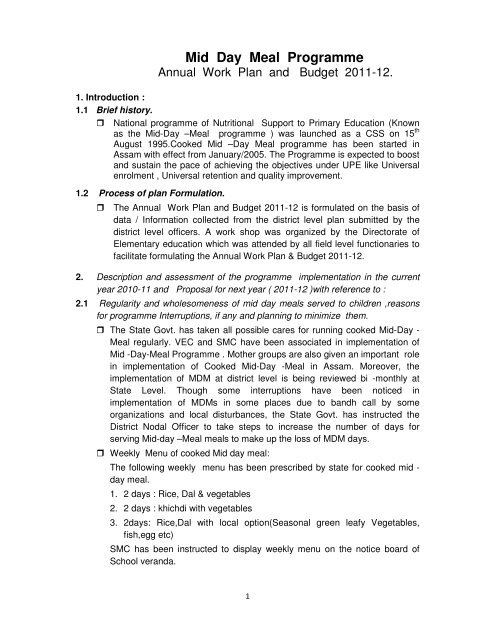
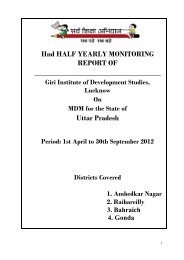
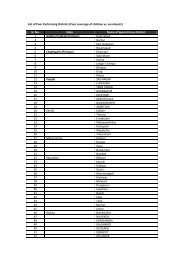
![Na National Programme Of Mid-Day-Meal in Schools [MDMS]tional ...](https://img.yumpu.com/51029020/1/184x260/na-national-programme-of-mid-day-meal-in-schools-mdmstional-.jpg?quality=85)
